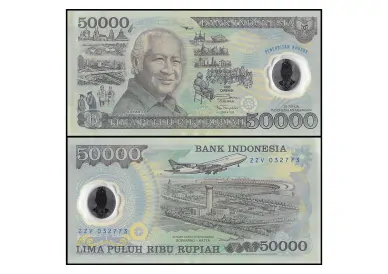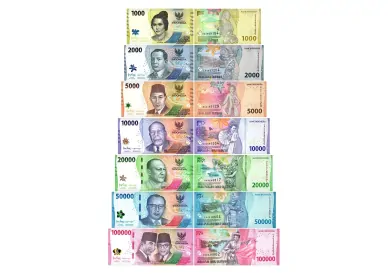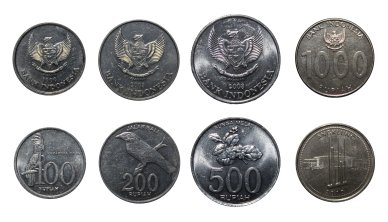Indonesian Rupiah
The Indonesian rupiah (IDR, Rp) is the official currency of Indonesia. It is not included in the list of reserve and freely convertible currencies.

History
Indonesia was a Dutch colony for a long time, and during WWII was under Japanese occupation.
For that reason, it did not have the national currency till 1945. Before that, the Dutch guldens and occupational rupiahs had been in circulation. Four years after the war for independence, the Indonesian government substituted those two currencies with completely new money.

1 Gulden Banknote, Netherlands East Indies
The Indonesian rupiah did not become the uniform currency for all provinces. The Riau Islands (till 1964) and the part of New Guinea that belonged to Indonesia (till 1971) released their own rupiahs, which replaced the official money later.
A difficult economic situation constantly led to the total depreciation of the Indonesian rupiah. In 1965, it reached such a level when revaluation was the only way out. In December of the same year, the rupiah issuing body Bank Indonesia released new banknotes that could be exchanged within the rate of 1:1,000.
For several decades, General Suharto governed the country and put tremendous effort into getting lucrative investments from the USA and other western countries. As a result, the Indonesian economy encountered times of revivification and stability.
During 1997 and 1998, the Asian countries faced a deep crisis that affected Indonesia too. As a result of the rupiah 30% drop, Suharto was overthrown. At that moment, the Rp-USD exchange rate was 2,000:1, and later it dropped to the catastrophic rate of 16,800 Rp:1 USD.
Seven kinds of banknotes in the denominations from Rp 1,000 to Rp 100,000 circulate nowadays. The minted coins have denominations from Rp 50 to Rp 1,000. The fractional currency sen was withdrawn in 1961 because of a high inflation rate, but now they are used only in cashless transactions.
Design

The Indonesian rupiahs exist as banknotes and coins. The fractional money usually contains the alloy of aluminum, albronze, and bimetals.
Banknotes
Traditionally, the banknotes of the Indonesian rupiahs are printed on paper. However, the polymer 50-rupiah and 100,000-rupiah banknotes appeared in 1993 and 1999.

Banknote of Indonesia in denomination of Rp 50,000, 1993, polymer
The first series appeared as a commemoration of the successful economic path that the country followed during the rule of General Suharto.
Bank Indonesia issued the second series to protect the national currency from counterfeiting. Nonetheless, the experiment failed because the polymer banknotes caused the malfunctioning of the counting machines, which were compatible only with paper money. Consequently, the Bank rejected the idea and began issuing regular money.
The banknotes issued in 2004-2005 and 2016 circulate in Indonesia and gradually replace the 1998-2001 series.
- Rp 1,000 is a blue-and-green banknote issued in 2000 that measures 141 mm by 65 mm. The obverse features the portrait of Thomas Matulessy (Pattimura), and the reverse has the images of a volcano and a fishing boat.
- Rp 2,000 is a brown-and-gray banknote that measures 143 mm by 65 mm and features the portrait of Prince Antasari of Banjar on the obverse and the image of the Dayak traditional dance on the reverse.
- Rp 5,000 is a brown-and-green banknote that measures 143 mm by 65 mm and features the portrait of Tuanku Bonjol on the obverse and the image of a songket weaver on the reverse.
- Rp 10,000 is a magenta banknote that measures 145 mm by 65 mm and depicts the portrait of Sultan Mahmud Badaruddin II on the obverse and a traditional Indonesian house on the reverse.
- Rp 20,000 is a green banknote that measures 147 mm by 65 mm and features the portrait of Oto Iskandar di Nata on the obverse and a tea plantation on the reverse.
- Rp 50,000 is a blue banknote that measures 149 mm by 65 mm and features the portrait of the commander I Gusti Ngurah Rai on the obverse and Lake Bratan on the reverse.
- Rp 100,000 is a red banknote that measures 151 mm by 65 mm. The obverse features the portraits of General Sukarno and Vice-President Mohammad Hata, and the reverse depicts the image of the Indonesian Parliament.
In 2006, a new series, completely different from the previous banknotes, was released.
- Rp 1,000 is a yellow banknote that measures 141 mm by 65 mm and features the portrait of Cut Nyak Meutia on the obverse and a Tifa dancer in the background of Banda Neira.
- Rp 2,000 is a gray banknote that measures 141 mm by 65 mm and features Mohammad Hoesni Thamrin on the obverse and a Piring dancer in the background of Sianok Canyon on the reverse.
- Rp 5,000 is a light brown banknote that measures 143 mm by 65 mm and features the portrait of Idham Chalid on the obverse and Bromo volcano and Gambyong dance on the reverse.
- Rp 10,000 is a purple banknote that measures 145 mm by 65 mm and features Frans Kaisiepo on the obverse and Wakatobi National Park and Pakarena dance on the reverse.
- Rp 20,000 is a light green banknote that measures 147 mm by 65 mm and features the portrait of Sam Ratulangi on the obverse and Derawan Islands and the Gong dance on the reverse.
- Rp 50,000 is a blue banknote that measures 149 mm by 65 mm and features the portrait of politician Djuanda Kartawidjaja on the obverse and Komodo National Park and a Legong dancer on the reverse.
- Rp 75,000 is a red-and-white banknote that measures 150 mm by 65 mm. The obverse includes the portraits of General Sukarno and Mohammad Hatta, the images of the flag hoisting ceremony, a part of Youtefa Bridge, and Jakarta MRT. The reverse depicts children wearing the Indonesian national costumes, a map of the country, and a satellite.
- Rp 100,000 is a red banknote that measures 151 mm by 65 mm. The obverse features the portraits of General Sukarno and Mohammad Hatta, and the reverse depicts the image of Raja Ampat Islands and a Topeng dancer.

Banknotes of Indonesia in denominations of Rp 1,000-100,000, 2022
Coins
The state-owned mint Perum Peruri mints Indonesian coins. There circulate the metallic money in denominations from Rp 50 to Rp 1,000 minted between 1991 and 2016.
The coins in the denomination of Rp 50 and higher are made of aluminum and albronze. The 1,000-rupiah coins are bimetallic or produced of steel and covered with nickel.

Coins of the Indonesian rupiah
Circulation in the World
The official currency of Indonesia has been pegged to seven reserve currencies since 1987. The USD-Rp exchange rate is 0, 000070:1 USD, whereas the EUR-Rp is 0,000059:1.
FAQ
When did the Indonesian rupiah (IDR, Rp) appear?
The Indonesian rupiah was introduced in 1946.
Why is the Indonesian currency called the rupiah?
The name "rupiah" is derived from the Sanskrit word "rupyakam," which means "silver coin."
What country uses the Indonesian rupiah?
The Indonesian rupiah is used in Indonesia. Therefore, if you are planning to visit Bali, Java, or other Indonesian islands, you will need to exchange your currency for rupiah.
What is the symbol and code of the Indonesian rupiah?
The symbol for the Indonesian rupiah is "Rp," and its ISO code is "IDR."
What are the denominations of the Indonesian rupiah?
The Indonesian rupiah comes in both coins and banknotes. Coins are available in denominations of 100, 200, 500, and 1,000 rupiah. Banknotes are issued in 1,000, 2,000, 5,000, 10,000, 20,000, 50,000, and 100,000 rupiah.
What is depicted on the Indonesian rupiah?
Indonesian rupiah banknotes feature national heroes, natural scenery, and landmarks of Indonesia. The designs vary between different series, reflecting various aspects of Indonesia's culture and history.







